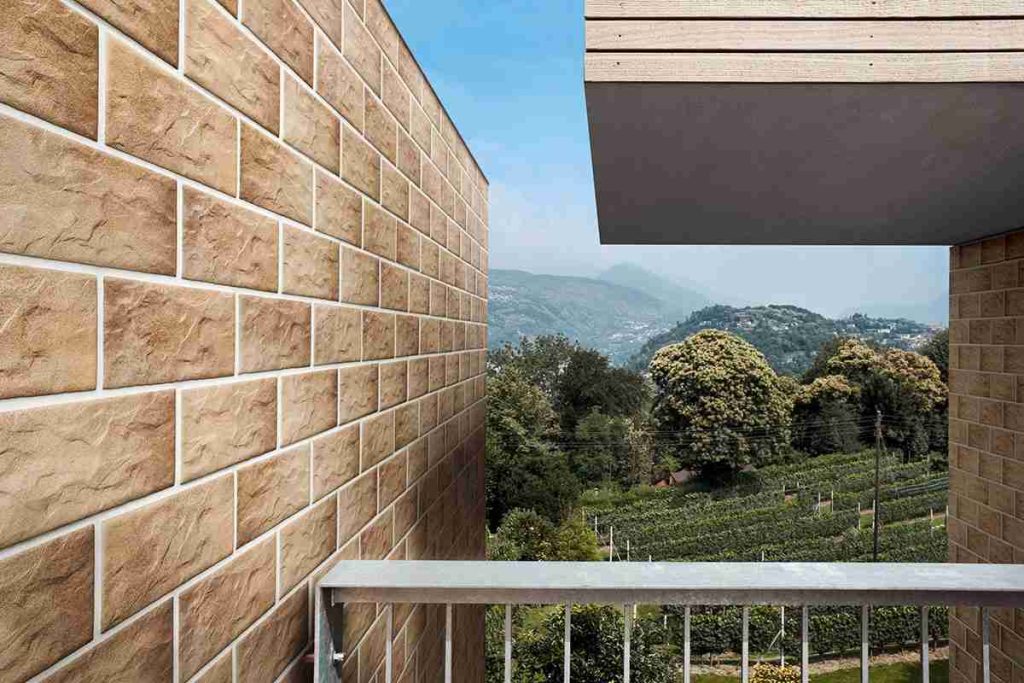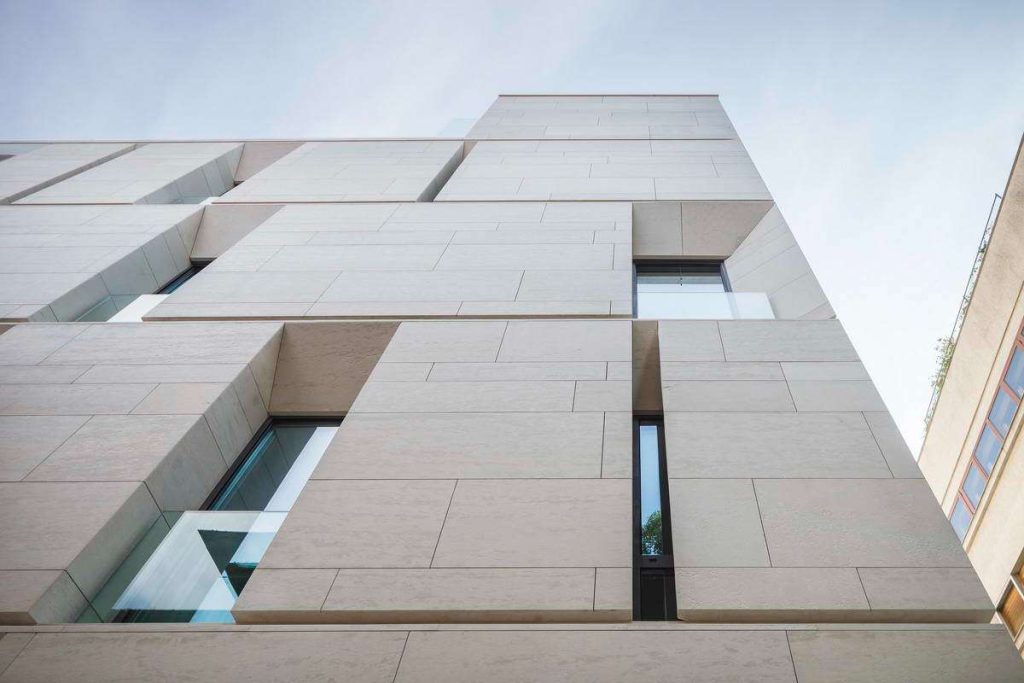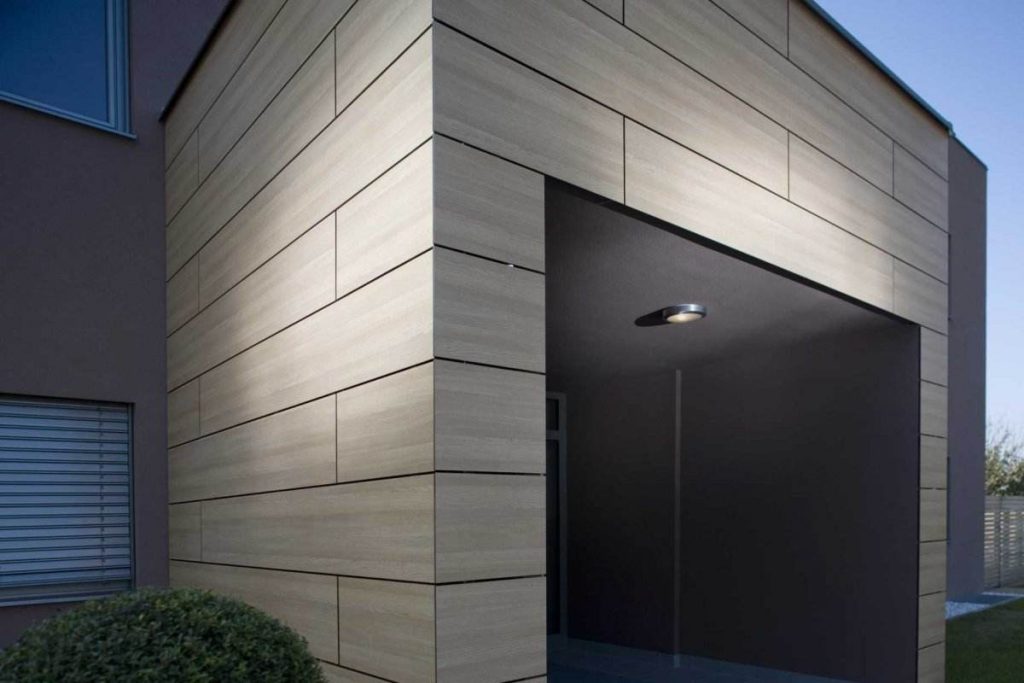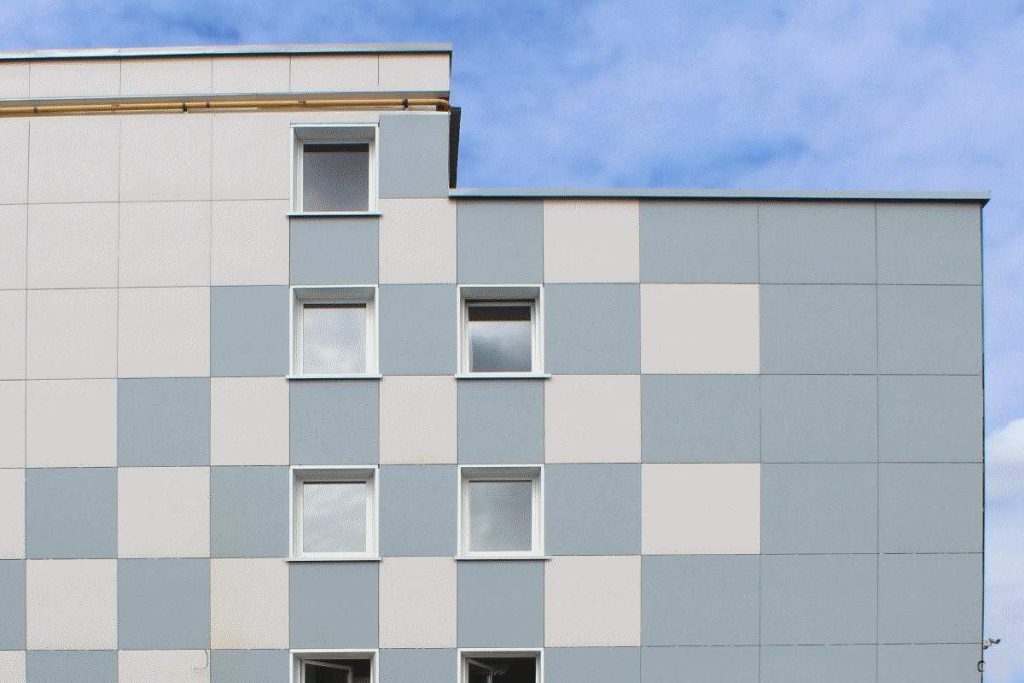Buildings have their own sense of personality, with the exterior and facade on their exterior, the use of ceramic tiles to present a beautiful and controlled facade in today’s architecture is very common.
The use of ceramic and tile coatings provides access to optimal performance with low maintenance. Depending on your desired result, we offer different solutions.
We start with a 100mm piece of clay brick (or comparable material) and then apply several coatings of a high-quality plastering product, which is treated in 24 hours and creates a weather resistant skin on the brick.

When the surface is completely dried, we then install 50 mm width concrete tiles at regular intervals. In some projects, there may be a need to drill holes into the tiles in order to provide ventilation. So, we have access panels between each tile to facilitate this work.
The concrete tiles are then covered with water-proof chemicals and sealed to protect the exterior against external elements and moisture penetration.
“We use a variety of protective treatments like anti-mold and anti-sabotage treatments to enhance security.
This is the optimal answer to achieve a system that is durable, beautiful, affordable and in need of low care. If you want additional information about our goods, please email us.
Ceramic views are ideal ways to add heat to any area. Design style is used in various form and style based on material.
Traditional ceramic tiles are often thicker and have more traditional appearance than other tiles. However, they provide a distinctive edge in terms of price and durability.
Since these materials are often used in construction, most people are familiar with their maintenance.
The ability to constantly change your home color and layout makes them perfect to any home layout. Instead of making everything at the same time, you should consider using modular units that can be aggregated into any order or combination.
- glass and fiberglass tiles
Ceramic and glass tiles are often thinner and more modern than fiberglass tiles. They are great for adding luminosity to any environment.

Most fiberglass and glass tile are formed in the same way as ceramic tiles from clay, sand and water. Because they are much lighter than ceramic tiles, it is easier to transport.
In addition, they offer a lot of variation if you want to change the wall size, because the thickness and length of the tiles are very variable.
If you need something more industrial and shiny, glass tiles may be the best option for you.
They are similarly made for fiberglass and glass, however they are made of molten glass instead of clay. In addition, these types of tiles are exceptionally durable and also excellent for different applications.
- stone tiles
Stone tiles are made of real stone and look like fine works of art. These tiles are available in a wide range of colors and shapes, making it easy to create a distinct pattern. Stone tiles are very popular and high-demand right now because of their high quality and appeal.
The best part about using stone tiles is that they are fully compatible; You can put them anywhere and change them to meet your individual needs.
Stone tiles are often used to create a rural space while clean in appearance.
The combination of stone tiles into your surroundings is the added advantages of reducing noise pollution. In order to reduce the level of noise, these materials help to absorb sound, especially in larger rooms and halls.
- concrete tiles
Besides ceramic, fiberglass and glass tiles, concrete tiles are colorful options. Because of its durability and high flexibility, these tiles are often used outside the home.

Concrete tiles are sometimes used as poor male earthen containers. In addition to being robust, they are very economical and may be very cheap.
Like any concrete product, they should be cleaned and properly sealed to prevent moisture damage. Also, concrete tiles cannot be stacked.
Each layer must be 12 inches apart. You can also add them into groups of two or three to make them more beautiful.
- metal tiles
Metal tiles are probably the most durable option listed above. Additionally, they are extremely varied and may be used both inside and outside the home. Metal tiles are often used in shopping centers and retail establishments because of their ability to withstand high temperatures.
How Are Ceramic Tiles Compared To Concrete?
Ceramic is the material of choice for any homeowners who want to make their house look beautiful, resist the test of time and stay forever.
But how do you ensure that you provide the best ceramic materials for your project? This tutorial will help you choose between the view of concrete tiles and ceramics.
Ceramic Tile Material and Cost
The initial factor is spent to include the decision time between the tile and ceramic views.
Depending on the size and complexity of the restoration process, the regular cost is between $10,000 and $40,000.

The use of concrete instead of the facade of ceramic tiles can save you in the long run (because the concrete is much cheaper than ceramics), but your home will lose its timeless beauty over time.
If on the other hand, you want to preserve the classic beauty while adding a modern touch, ceramic tile may walk. They appear differently from the fact that they are made exclusively for foreign applications.
“Moreover, unlike concrete, this type of concrete does not require expensive maintenance. Moreover, they may be designed according to your personal design taste.
Here’s how to compare each material in terms of appearance, durability and longevity if you prefer to use the View Installation in general and the Vinyl Color Selection.
Ceramic tile façade
The importance of facade in buildings is the fact that the building is featured prominently in the shape of its front facade of exterior brick or ceramic tiles, there are various ideas of which materials are more suitable for coating.
Visual Effect – Make sure the home view makes it more attractive. To improve your home’s aesthetic appeal, take note of the color, texture, pattern, and even lighting effects.
Energy efficiency – although not directly connected to your home’s aesthetics, ceramic tiles are incredibly energy efficient. They are not only aesthetically pleasing, they save the cost of heating and cooling!
If you live in an area where climate conditions can cause damage, consider using ceramic tiles for outside of your home. They are suitable for homes in colder regions because of their long life span.
Since they are water-resistant, tiles may be placed on concrete bases without the fear of breaking. This makes them ideal for homes in coastal areas with heavy rainfall.
Once installed, you no longer have to worry about painting or painting your house. The housekeeper need not take more time to care for the beauty of her house; because they are not undergoing maintenance.
Flexibility – Regardless of the external design you choose for your home, ceramic tiles are applicable to any style.
The design for tiles can range from contemporary to conventional. For example, some designers may use patterns and colors that are comparable to those found at home. Some of them have distinct but timeless designs that are specific to the population.
Affordable – Ceramic tiles are often cheaper than other options like stuco. Even if you choose a different material, ceramic tiles are a very good alternative to stone or brick, which requires more work and material costs.










Your comment submitted.